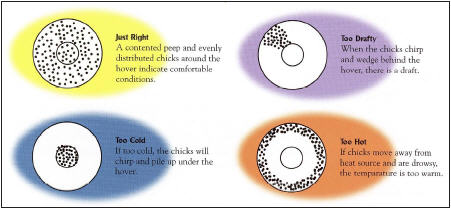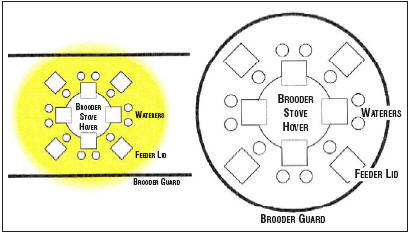



Getting Started with the Home Poultry Flock
By Dr. Mickey A. Latour and Dr. Todd J. Applegate, Department of Animal Sciences, University of Purdue - The desire to begin raising poultry must be carefully considered before the first purchase. As the husbandry person, you will need to become acquainted with a variety of potential issues before the first purchase.Introduction
First you should investigate and determine if there are any zone, community, or local restrictions limiting the size of fl ock or prohibiting you from having birds. In addition and while you are visiting the building commissioner, ask about restrictions and/or permits to construct a pen for these birds. Once this is done, you will need to decide on what type of birds you really prefer, e.g., birds for meat consumption, layer hens, 4-H showing hens, or a combination. Regardless of choice, the decision should be made up front, because purchasing the wrong type(s) of birds can be costly, and you will obligated to care for something you didn’t really intend to have.
Housing of Birds
Depending on what type of bird(s) you are interested
in purchasing, you will need to prepare a shelter. In
preparing a shelter, you should give consideration to
the location on your property and potential threat of
predators, i.e., raccoons, coyotes, cats, and dogs. It
may require, depending on your location, that some
of the fencing wire be buried below the surface to
prevent any of these aforementioned predators from
getting to the birds. Along that line, be sure the fence
wire size is small enough to prevent other critters,
i.e., minks, weasels, etc., along the outside edge
to access the birds. Lastly, you will want to give
some consideration to proximity to the house before
construction begins, because you may decide to run
electricity and/or water to the facility, which will be
nice when you need light, heat, and water. You will
want to choose a location which drains well, because
birds move a lot during the day following a rain
whereupon they will make a tremendous mess.
As for bird space, home fl ocks are given space at
approximately 3' x 3' per bird, so if you want 20 birds,
you will need 180 square feet of fl oor space which is
equal to a 10' x 18' pen. In general, fl ocks experience
some level of death loss, and in the example above you
might try over stocking by 10 to 15 percent, i.e., two
to three more additional birds beyond the 20 because
through death loss, you will achieve the desired ratio
of birds to fl oor space.
As mentioned, you will have death losses, so
you will need to give consideration on how you
want to dispose of the bird(s). For a better
understanding of bird disposal within the state of
Indiana, visit the Indiana Board of Animal Health,
http://www.state.in.us/boah/.
As for temperature, birds (four weeks of age or
older) are best suited for 70oF, and like humans, they
can endure a wide range of temperatures. In Indiana,
there are two very important times to really watch
birds: extreme winter and extreme summer. During
extreme conditions, i.e., below freezing, birds will
begin to shunt blood away from extremities, especially
the comb and toes. If this occurs, you will see those
areas become blue/black and eventually fall off do to
frost bite. Conversely, during extreme heat, above
90oF it becomes important to monitor available cooling
areas (mist or shade). Drinking water should be less
than 80oF. When the water temperature rises above
80oF, birds tend to refuse drinking water.

Figure 1: Brooding area temperature is important.
As mentioned above, the location should be well drained. Depending on how you construct the pen, a good absorbent litter may be included. Some of the most common litter choices are pine shavings, rice hulls, or ground corn cobs. Another good choice for bedding materials during the wet season is sand, because it allows for excellent drainage. You should avoid using hardwood shavings, because they potentially provide a good environment for molds.
Placing the Birds
If you are placing newly hatched chicks, it will
be important to have the brooding area ready when
they arrive (Figure 1); that is, you will want the room
temperature around 70 to 75oF with the temperature
at chicks’ level to be 95oF during the first week. The
area assigned to these chicks should have some
flexibility such that they can move through a range
of temperatures (95 to 75oF). During this period, it
will be important to monitor the birds for signs of
stress; for instance, if the chicks are scattered around
the area and chirping loudly, chances are they are
hot; conversely, if you notice the chicks all huddled
together in one area, they are likely cold (Figure 2).
At the end of Week 1, begin dropping the temperature
by 5oF per week until you reach 70oF, and then try to
maintain that temperature.

Figure 2: Monitor brooding area for signs of stress.
Water and Feed
The most neglected and overlooked nutrient is water.
In many cases, humans walk by what appears to be
a bowl of “clean water;” but in fact, it may contain
millions of bacteria. In turn, the bacteria will stress
the digestive system of the bird, such that it will not
grow at the rate believed to be their potential. As a
good practice, the water bowl or dispenser for birds
should be cleaned and monitored on a routine basis.
In addition, the actual bowl and other items should be
cleaned routinely (weekly or sooner) with a product
like chlorine to reduce the incidence of microbial
formation. Fresh water needs to be supplied everyday
to insure healthy birds. As mentioned in the Placing
Birds Section, there are critical times in which the
care provider must monitor water, extreme cold, and
extreme heat. Obviously, during the cold periods, the
biggest concern will be freezing. Many farm supply
stores sell heaters specifically designed to keep water
from freezing, so this might be needed during an
extremely cold period. Likewise, during the extreme
heat, you will want to monitor water temperature and
make sure there is an ample supply of “fresh cool”
drinking water. As mentioned above, birds may refuse
to drink when the water temperature is above 80oF. In
addition, during the periods of extreme heat, there is
an increased risk of microbial growth.
A more detailed paper will be present on feed related
to making a ration. For the average homeowner or
individual showing birds or rearing layers for egg
production, there is a wide range of high quality feeds
available from many different sources. There are some
general factors an individual should keep in mind
when selecting a feed: A) Make sure it is the correct
feed for the application; for instance, don’t choose
a meat type ration when you are wanting layers to
lay eggs. B) Be sure to look over the ingredients, so
that it meets your requirements; that is, if you want
a ration free of meat and bone meal, then just look at
the ingredient list across brands. Perhaps the biggest
challenge an individual will face is “deciding on which
brand” to purchase.
Source: Purdue University Extension Service - February 2005








